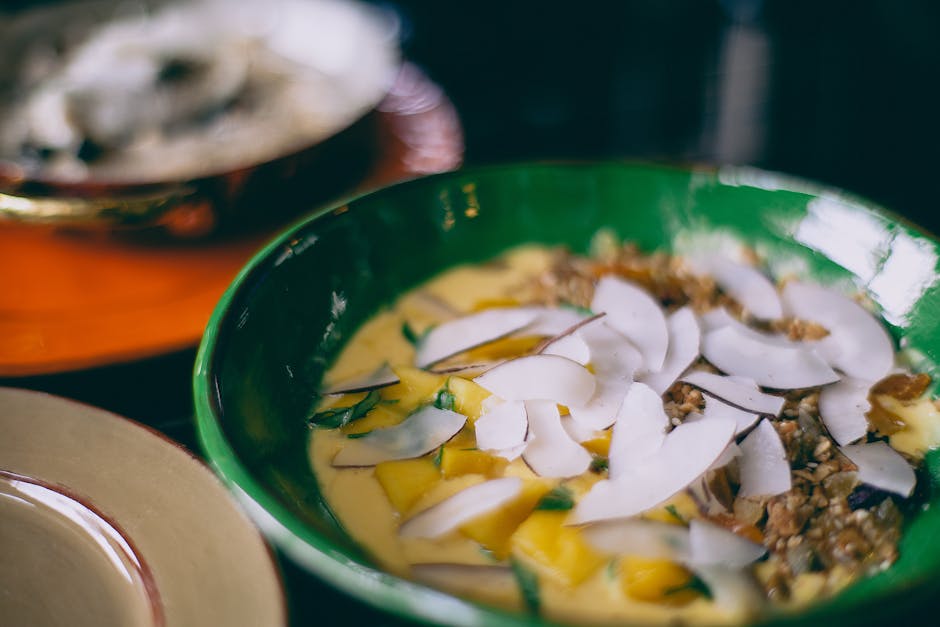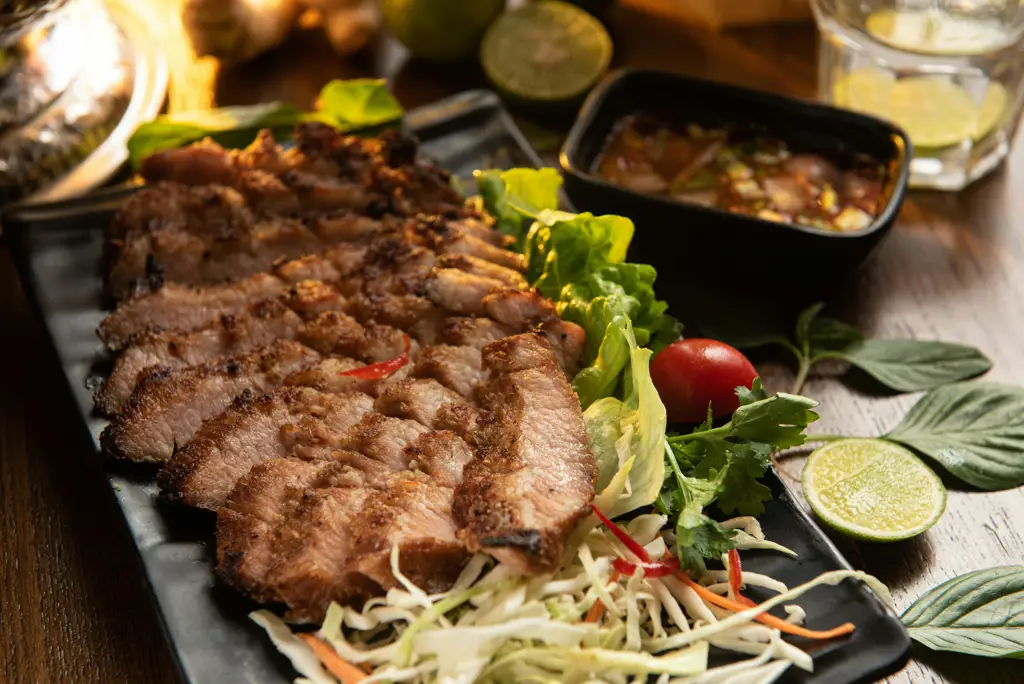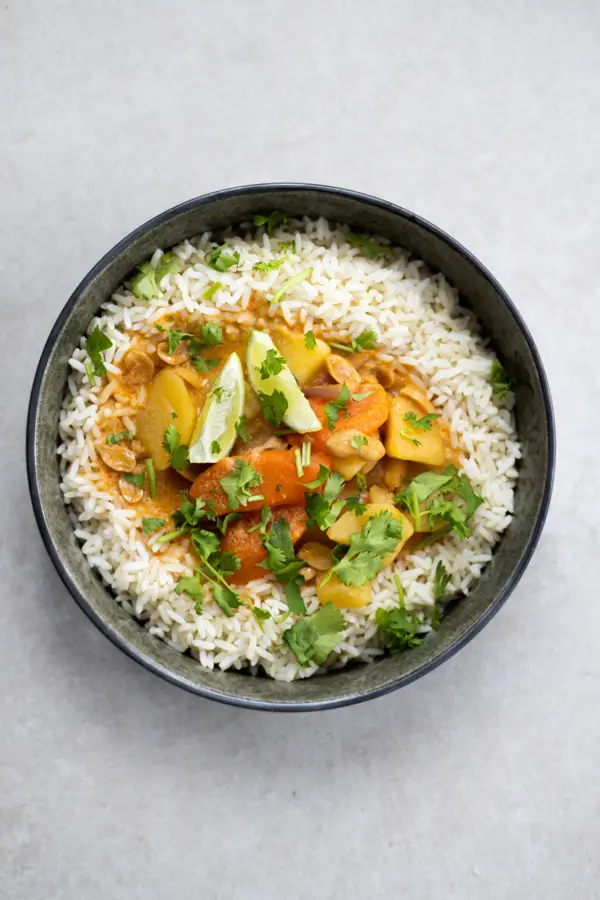Easy Thai Coconut Soup, a culinary delight that embodies the vibrant flavors of Thailand, offers a delicious and accessible entry point into the rich tapestry of Thai cuisine. While pinpointing the exact origin of this specific soup is difficult, its foundation lies within the broader history of Thai cooking, a tradition deeply intertwined with its agricultural landscape and cultural exchanges. Thailand’s fertile rice paddies and abundant coconut groves have long provided the essential ingredients for countless coconut-based dishes, with coconut milk serving as a crucial element in many soups, curries, and desserts. The use of coconut in Thai cooking dates back centuries, predating even widespread European influence. Its creamy texture and subtle sweetness perfectly complement the often spicy and savory notes characteristic of Thai food.
The historical context of Thai coconut soup is inextricably linked to the country’s diverse cultural influences. Over centuries, Thailand has absorbed culinary traditions from neighboring countries like China, India, and Laos, leading to a unique fusion of flavors and techniques. The use of lemongrass, galangal, and kaffir lime leaves, all prominent in this soup, reflects the country’s rich botanical heritage and its ingenious use of aromatic herbs and spices. These ingredients, along with the ubiquitous coconut milk, create a complex flavor profile that is both comforting and exciting, a hallmark of Thai gastronomy. While specific recipes for Easy Thai Coconut Soup might be a more modern creation, adapted for ease of home cooking, the fundamental components have deep roots in the traditional culinary practices of Thailand.
The cultural significance of coconut soup, in its various forms, within Thai society is substantial. It’s not just a dish; it’s often a symbol of hospitality and generosity. Coconut milk, a symbol of abundance and prosperity, frequently features in celebratory meals and festive occasions. Moreover, the soup’s adaptability allows for regional variations, reflecting the diversity of Thailand’s culinary landscape. Different regions might incorporate unique ingredients, reflecting local availability and preferences. Statistics show that coconut-based dishes comprise a significant portion of everyday meals in Thailand, highlighting coconut’s importance in the national diet. This accessibility and popularity contribute to its integral role in Thai culture, transcending mere sustenance to become a vital part of the nation’s culinary identity and social fabric.
Finally, the appeal of an Easy Thai Coconut Soup lies in its accessibility. While authentic Thai cooking can be complex, requiring specialized ingredients and techniques, simplified versions like this recipe offer a gateway to experiencing the deliciousness of Thai flavors without intimidation. This democratization of Thai cuisine allows more people to enjoy the vibrant flavors and cultural richness of Thailand, furthering its international recognition and appreciation. The increasing popularity of Thai food globally, reflected in the numerous restaurants and cookbooks dedicated to it, testifies to the enduring allure of its unique and flavorful dishes, with easy recipes like this coconut soup playing a significant role in broadening its appeal.
Ingredients and Measurements
This recipe for Easy Thai Coconut Soup yields approximately 4 servings. Accurate measurements are crucial for achieving the perfect balance of flavors, so please use a kitchen scale for the most precise results, especially for the aromatics. If you don’t have a scale, use accurate measuring cups and spoons, ensuring you level off ingredients appropriately.
Broth: We’ll start with the foundation of our soup – a flavorful broth. You have options here! For the richest flavor, use 4 cups (950ml) of homemade chicken or vegetable broth. If you’re short on time, 4 cups (950ml) of high-quality store-bought low-sodium broth will work perfectly well. Avoid using overly salty broth, as you can adjust seasoning later.
Coconut Milk: The creamy heart of Thai Coconut Soup is, of course, coconut milk! We recommend using 1 (13.5 ounce/390ml) can of full-fat coconut milk. This provides the necessary richness and creaminess. Avoid using light coconut milk, as it will lack the desired texture and flavor. Make sure to shake the can well before opening to ensure even distribution of coconut cream.
Aromatics: The aromatic base is essential for the authentic Thai flavor profile. Use: 1 stalk lemongrass, thinly sliced (about 2 tablespoons). Remove the tough outer layers before slicing. 2-3 cloves garlic, minced – the amount depends on your garlic preference. 1 inch ginger, peeled and minced or grated (about 1 tablespoon). Fresh ginger is best, but you can substitute with 1 teaspoon of ground ginger in a pinch. 1-2 Thai red chilies, finely chopped (adjust to your spice preference). If you are sensitive to spice, start with one chili and add more to taste. Remember to wear gloves while handling chilies to prevent skin irritation.
Vegetables: We’ll use a combination of vegetables to add both flavor and texture. Use: 1 cup (150g) mushrooms, sliced – any variety of mushrooms will work, such as cremini, shiitake, or oyster mushrooms. 1 cup (100g) carrots, thinly sliced – choose young, tender carrots for the best results. 1 cup (100g) snow peas, trimmed – these add a nice crunch and vibrant green color. 1/2 cup (50g) chopped cilantro, for garnish. Fresh cilantro is highly recommended for the best flavor.
Other Ingredients: These add the finishing touches to the soup. Use: 2 tablespoons fish sauce – this is a key ingredient in Thai cuisine, providing a savory umami flavor. 1 tablespoon lime juice – adds a touch of acidity to balance the richness of the coconut milk. 1 tablespoon brown sugar – balances the saltiness and adds a subtle sweetness. Optional: 1/4 cup (30g) cooked rice noodles or vermicelli, added at the end for extra heartiness.
Important Note: Adjust the amounts of fish sauce, lime juice, and brown sugar to your taste. Start with the suggested amounts, and then add more or less according to your preference. Taste the soup throughout the cooking process and adjust accordingly. Always taste before serving to ensure the flavors are well-balanced.
Equipment List
Making a delicious and authentic Easy Thai Coconut Soup requires the right tools. While you might already have most of these items in your kitchen, having the correct equipment will significantly enhance your cooking experience and ensure a smoother, more efficient process. This list details the essential and recommended equipment, along with explanations to help you make informed choices.
Large Stockpot or Dutch Oven (6-8 quart capacity): This is the workhorse of your soup-making process. A large capacity is crucial to accommodate all the ingredients comfortably, preventing overcrowding and ensuring even cooking. A heavy-bottomed pot, like a Dutch oven, is particularly recommended as it distributes heat evenly, preventing scorching and promoting a smoother simmer. Look for one made of stainless steel or enameled cast iron for optimal heat retention and durability.
Immersion Blender (stick blender): While you can use a regular blender, an immersion blender is highly recommended for this recipe. It allows you to blend the soup directly in the pot, eliminating the need for transferring hot liquids and reducing the risk of spills and burns. An immersion blender saves significant time and effort, resulting in a perfectly creamy soup texture without the mess.
Cutting Board (large, sturdy): You’ll need a spacious cutting board to comfortably chop vegetables like galangal, lemongrass, and chilies. A large, sturdy cutting board made of wood or high-quality plastic will provide a stable surface and prevent slippage during preparation. Remember to use separate cutting boards for raw meats and vegetables to maintain hygiene.
Sharp Chef’s Knife: A sharp chef’s knife is essential for efficient and safe vegetable preparation. A dull knife requires more force, increasing the risk of accidents. A good quality chef’s knife (approximately 8 inches) will make quick work of chopping, mincing, and slicing, ensuring consistent sizes for even cooking.
Measuring Cups and Spoons: Accurate measurements are critical for achieving the desired flavor balance in your soup. Invest in a reliable set of measuring cups and spoons to ensure consistency in your cooking. Using accurate measurements is key to replicating the recipe successfully.
Wooden Spoon or Spatula: A sturdy wooden spoon or spatula is ideal for stirring the soup while it simmers. Avoid using metal utensils, as these can scratch the surface of nonstick pots and pans. The wooden spoon’s heat resistance and gentle stirring action make it perfect for preventing sticking and ensuring even cooking.
Fine-Mesh Sieve or Strainer: While optional, a fine-mesh sieve or strainer can be used to remove any solids from the soup after blending, if you prefer a smoother texture. This is especially helpful if you are using whole chilies, as it removes any lingering bits of chili seeds.
Serving Bowls: Finally, you’ll need attractive serving bowls to present your delicious Thai Coconut Soup. Choose bowls that complement the dish’s presentation and are comfortable to hold.
Preparation Phase: Vegetable Prep
Proper vegetable preparation is crucial for achieving the best flavor and texture in your Easy Thai Coconut Soup. This phase focuses on efficiently prepping the vegetables to ensure even cooking and a vibrant final dish. We’ll be working with a variety of vegetables, each requiring slightly different treatment.
Begin by gathering all your vegetables: 1 large onion (about 1 cup chopped), 2 cloves garlic (minced), 1 inch ginger (minced), 2 carrots (peeled and thinly sliced, about 1 cup), 1 red bell pepper (seeded and thinly sliced, about 1 cup), 1 cup broccoli florets, and 1 cup mushrooms (sliced). Having everything measured and ready to go will streamline the cooking process.
Start with the onion. Properly dicing your onion is key to preventing harsh raw onion flavor in the final soup. Aim for a consistent, ½-inch dice. This ensures even cooking and prevents some pieces from becoming overly browned while others remain raw. A sharp knife is essential for this task; a dull knife will crush the onion cells, releasing more of the pungent compounds.
Next, mince the garlic and ginger. Use a fine mince for both, as this allows their flavors to fully infuse into the soup base. A microplane grater can be particularly helpful for the ginger, ensuring a smooth paste with no stringy bits. If using a knife, work quickly and efficiently to prevent the strong aromas from overwhelming your kitchen!
The carrots, bell pepper, and mushrooms should be thinly sliced for even cooking. Aim for slices that are roughly ¼-inch thick. This will allow them to soften nicely without becoming mushy. For the carrots, peeling is important for a smoother texture and to remove any potential pesticides. If you’re pressed for time, a vegetable peeler and mandoline slicer can greatly speed up this process.
Finally, prepare the broccoli. Break the broccoli head into small florets, roughly 1-inch in size. Avoid overly large florets as they may not cook through evenly. Smaller florets also contribute to a more visually appealing soup. Wash all the vegetables thoroughly under cold running water to remove any dirt or debris before proceeding to the next stage.
Professional Tip: Mise en place, the French culinary term for “everything in its place,” is highly recommended. Having all your vegetables prepped and measured before you begin cooking will significantly improve your efficiency and reduce stress in the kitchen. This allows for a smoother, more enjoyable cooking experience.
Once all your vegetables are prepped, store them in separate bowls or containers to keep them organized and prevent cross-contamination of flavors. Now you’re ready to move on to the next stage of making your delicious Thai Coconut Soup!
Preparation Phase: Marinade (if applicable)
While not strictly necessary for a quick and easy Thai Coconut Soup, marinating the protein can significantly enhance the flavour profile. This section outlines optional marinades for chicken, shrimp, or tofu, offering variations to suit your preference.
Choosing Your Protein: The choice of protein dictates the marinade’s duration and intensity. Chicken benefits from a longer marinade (at least 30 minutes, ideally 2-4 hours), while shrimp and tofu require less time (15-30 minutes) to avoid over-tenderizing or becoming mushy.
Marinade for Chicken (serves 4): This marinade balances sweet, savory, and spicy elements, complementing the coconut milk’s richness. Combine the following ingredients in a bowl:
- 1/4 cup fish sauce (adjust to taste)
- 2 tablespoons soy sauce (low sodium preferred)
- 2 tablespoons brown sugar
- 1 tablespoon lime juice
- 1 tablespoon grated fresh ginger
- 2 cloves garlic, minced
- 1-2 Thai red chilies, finely chopped (adjust to your spice preference)
- 1 pound boneless, skinless chicken breasts, cut into bite-sized pieces
Instructions: Place the chicken pieces in a resealable bag or shallow dish. Pour the marinade over the chicken, ensuring it’s evenly coated. Seal the bag or cover the dish and refrigerate for at least 30 minutes, or up to 4 hours for optimal flavour. Discard any remaining marinade after use.
Marinade for Shrimp (serves 4): Shrimp marinates quickly, so a shorter time is crucial. Use a lighter marinade to avoid overpowering the delicate flavour of the shrimp:
- 2 tablespoons fish sauce
- 1 tablespoon lime juice
- 1 teaspoon grated fresh ginger
- 1 clove garlic, minced
- 1/2 teaspoon sugar
- 1/2 teaspoon ground white pepper
- 1 pound shrimp, peeled and deveined
Instructions: Gently toss the shrimp with the marinade ingredients. Let it sit for 15-20 minutes before adding to the soup. Over-marinating shrimp can make it tough.
Marinade for Tofu (serves 4): Firm or extra-firm tofu works best. Press the tofu to remove excess water before marinating:
- 2 tablespoons soy sauce
- 1 tablespoon sesame oil
- 1 tablespoon rice vinegar
- 1 teaspoon cornstarch
- 1/2 teaspoon ground ginger
- 1/4 teaspoon black pepper
- 1 block (14oz) firm or extra-firm tofu, pressed and cubed
Instructions: Combine all ingredients except tofu in a bowl. Add the cubed tofu and toss gently to coat. Marinate for at least 15 minutes, or up to 30 minutes. The cornstarch helps create a slightly crispy exterior when the tofu is added to the soup.
Important Note: Adjust the amount of chili in any marinade to suit your spice preference. Always remember food safety practices – keep marinated proteins refrigerated and use promptly.
Cooking Techniques: Broth Preparation
The foundation of any delicious Thai Coconut Soup is a flavorful and aromatic broth. This section details the process of creating a rich and nuanced broth that will elevate your soup to the next level. We’ll be focusing on a vegetable broth, easily adaptable to your preferences and dietary needs. While you can use store-bought broth, making your own allows for complete control over flavor and avoids unnecessary additives.
Ingredients for Vegetable Broth (makes approximately 6 cups):
- 1 tablespoon coconut oil
- 1 large onion, roughly chopped
- 2 carrots, roughly chopped
- 2 celery stalks, roughly chopped
- 3 cloves garlic, smashed
- 1 inch ginger, peeled and roughly chopped
- 4 cups vegetable broth (low sodium preferred)
- 4 cups water
- 1 lemongrass stalk, bruised (white part only, remove tough outer leaves)
- 2 kaffir lime leaves
- 1 teaspoon coriander seeds
- 1/2 teaspoon white peppercorns
- 1/4 teaspoon red pepper flakes (optional, adjust to taste)
Instructions:
Step 1: Sauté Aromatics: Heat the coconut oil in a large pot or Dutch oven over medium heat. Add the onion, carrots, and celery and cook until softened, about 5-7 minutes. Don’t brown the vegetables, just gently soften them to release their flavors.
Step 2: Build Flavor: Add the garlic, ginger, lemongrass, kaffir lime leaves, coriander seeds, white peppercorns, and red pepper flakes (if using). Cook for another minute, stirring constantly, until fragrant. This step is crucial for developing a complex and aromatic broth.
Step 3: Simmer the Broth: Pour in the vegetable broth and water. Bring the mixture to a boil, then reduce heat to low, cover, and simmer for at least 30 minutes, or up to 1 hour for a deeper flavor. The longer it simmers, the richer the broth will become.
Step 4: Strain the Broth: Once simmered, remove the pot from the heat and let it cool slightly. Strain the broth through a fine-mesh sieve or cheesecloth lined colander into a clean container, pressing on the solids to extract as much liquid as possible. Discard the solids.
Step 5: Adjust Seasoning: Taste the broth and adjust the seasoning as needed. You may want to add a pinch more salt, pepper, or a squeeze of lime juice to brighten the flavors. This is your chance to personalize the broth to your liking.
Professional Recommendations:
- For a richer broth, consider adding a few mushrooms (shiitake or cremini) to the sautéing stage.
- If you don’t have fresh lemongrass or kaffir lime leaves, you can substitute with 1 teaspoon of lemongrass paste and 1/2 teaspoon of lime zest.
- Always use high-quality ingredients for the best results. The flavor of your broth will directly reflect the quality of your ingredients.
- Let the broth cool completely before storing in the refrigerator for up to 3 days or freezing for longer storage.
With this flavorful broth as your base, your Thai Coconut Soup is sure to be a success!
Cooking Techniques: Simmering and Flavor Development
This section delves into the crucial technique of simmering, essential for developing the rich and nuanced flavors of our Easy Thai Coconut Soup. Simmering, unlike boiling, involves gently heating a liquid just below its boiling point, producing a slow, even heat that extracts maximum flavor from ingredients while maintaining their texture.
For our recipe, we’ll be simmering the soup base for at least 20 minutes, allowing the aromatics and spices to fully infuse the broth. This gentle cooking process is key to unlocking the unique taste profile of Thai cuisine. Don’t rush this step! The longer you simmer (within reason), the more complex and delicious your soup will become.
Begin by preparing your aromatics. We’ll use approximately 2 stalks of lemongrass (bruised gently to release their oils), 3-4 kaffir lime leaves (slightly torn for better flavor release), 1 inch of ginger (finely minced or grated), and 2-3 cloves of garlic (minced). These quantities are guidelines; adjust according to your preference. Remember to bruise the lemongrass to release its essential oils – this is crucial for flavor development.
Next, add 4 cups of vegetable broth (or chicken broth for a richer flavor) to a medium-sized pot. Add the prepared aromatics and bring the mixture to a gentle simmer over medium heat. You should see tiny bubbles rising slowly to the surface, not a vigorous boil. A rolling boil will cause the aromatics to become bitter and potentially burn.
Once simmering, reduce the heat to low, ensuring the liquid remains at a gentle simmer. Cover the pot partially to allow some steam to escape but maintain a consistent temperature. Maintain a low, even simmer for at least 20 minutes, or up to 30 minutes for a more intense flavor. Stir occasionally to prevent sticking.
During this simmering process, the flavors of the aromatics will gradually meld together, creating a fragrant and complex base for your soup. The lemongrass will impart its citrusy notes, the ginger its warmth and spice, and the garlic its savory depth. The kaffir lime leaves contribute a unique, slightly floral aroma that is quintessential to Thai cuisine. Patience is key; the slow simmering allows for a harmonious blending of flavors that cannot be achieved through rapid cooking.
After simmering, carefully strain the broth through a fine-mesh sieve to remove the solids. Discard the solids or save them for another use (such as adding them to a stir-fry for extra flavor). The resulting broth will be clear, fragrant, and intensely flavorful, ready to receive the remaining ingredients of your delicious Easy Thai Coconut Soup.
Professional Recommendation: For an even more complex flavor profile, consider adding a small piece (about 1 inch) of galangal to the simmering broth along with the other aromatics. Galangal offers a slightly peppery and earthy note that complements the other ingredients beautifully.
Recommendations for Easy Thai Coconut Soup
This Easy Thai Coconut Soup is a delicious and healthy meal, perfect for a weeknight dinner or a light lunch. To enhance your enjoyment and maximize its potential, consider these recommendations:
Serving Suggestions: For a truly authentic experience, serve your Easy Thai Coconut Soup hot, straight from the pot. Garnish generously with fresh cilantro, a squeeze of lime juice, and a sprinkle of red pepper flakes for an extra kick. A dollop of coconut cream adds richness and visual appeal. For a heartier meal, consider serving it with a side of steamed jasmine rice to soak up the flavorful broth. Alternatively, serve it with crusty bread for dipping. You can also add cooked chicken, shrimp, tofu, or vegetables like mushrooms or spinach for added protein and nutrients.
Storage Conditions: Leftover Easy Thai Coconut Soup can be stored in an airtight container in the refrigerator for up to 3 days. Avoid storing it for longer than this to maintain freshness and prevent bacterial growth. When reheating, gently warm it on the stovetop or in the microwave, ensuring it’s heated thoroughly before serving. Do not refreeze the soup after it has been thawed.
Complementary Dishes: This soup pairs beautifully with a variety of dishes. A fresh green salad with a light vinaigrette would offer a refreshing counterpoint to the richness of the soup. For a more substantial meal, consider serving it alongside spring rolls or satay skewers. The flavors of the soup also complement grilled fish or chicken, providing a complete and balanced meal. If you’re looking for a dessert to finish the meal, a light and refreshing mango sticky rice or coconut ice cream would be a perfect complement.
Nutritional Information (Approximate per serving, based on a standard recipe): Please note that this is an estimate and may vary depending on the specific ingredients used and serving size. Calories: Approximately 250-300 calories per serving. Protein: 5-7 grams. Fat: 15-20 grams (mostly healthy fats from coconut milk). Carbohydrates: 20-25 grams. Fiber: 2-4 grams. This soup is a good source of Vitamin C, Vitamin E and other essential minerals depending on the added ingredients.
Important Note: The nutritional information provided is an estimate and may vary based on the specific ingredients used and the portion size. For accurate nutritional information, you are encouraged to use a nutritional calculator with the specific ingredients and quantities used in your recipe. Always adjust the recipe to meet your individual dietary needs and preferences. Adjust the amount of coconut milk for a lighter or richer soup. Add more vegetables for added fiber and nutrients. Experiment with different spices and herbs to create your own unique flavor profile.





